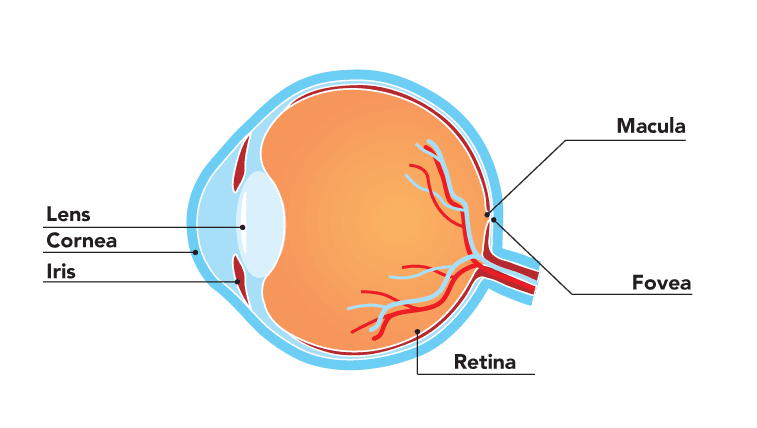What is Geographic Atrophy (GA)?
Geographic atrophy (GA) is an advanced form of dry age-related macular degeneration (commonly referred to as AMD). AMD is a disease that affects part of the back of the eye called the macula. The macula is the central part of the retina, which is the “film” lining the inside of the eye. Some patients with AMD will develop GA, an advanced form of the dry type of AMD. In GA, areas of the retina experience cell death (atrophy). These areas can grow and may result in a dim or blind spot in your vision. GA often first develops near the fovea, the center of the macula, which is the central and clearest part of your vision. Since the most center part of vision may not be affected at first, this may allow some with GA to keep a small area of central vision leading to possible delays in diagnosis of GA. GA can lead to progressive and permanent vision loss. If you have GA in one eye, you are more likely to develop it in the other eye. It is estimated that 1 million people in the United States have GA.


Normal Vision and Geographic Atrophy
What increases your risk for geographic atrophy?
While the cause of GA is unknown, the following can increase your risk for GA:
- Family history of AMD
- Age – over 60 years old
- Race – Caucasians have a higher rate of AMD
- Light colored eyes
- Smoking
- Genetics
- Heart disease
- Diabetes
- Women not using menopausal hormone replacement therapy
- High blood pressure (hypertension)
- High cholesterol
- Obesity
- High sun exposure throughout the life span
- Poor diet with a low intake of fruits and vegetables (specifically dark green leafy vegetables)
What symptoms could you have with geographic atrophy?
There may be no symptoms in the early stages until the disease progresses or affects both eyes. Vision changes due to GA may include:
- Difficulty seeing in the center of your vision, which is needed for reading, crafts, cooking, recognizing faces, and driving
- Numbers or letters disappearing or missing when reading
- A dim or dark spot in your central or near central (side) vision
- Trouble seeing in dim light
- Needing extra light to read
- Dull or washed out colors
- Vision not as clear or sharp
If you experience any of these symptoms, see an eye doctor as soon as possible.
How is geographic atrophy diagnosed?
If you are 50 years old or older, you should get a complete eye exam every one or two years or as indicated by your eye doctor. It is important to attend all scheduled eye exams even if you have no noticeable vision problems.
During the eye exam, the eye doctor will conduct the following tests, among others:
- Visual acuity: This test will find out how well you can see through your central vision in each eye. This is the part of the exam when you read an eye chart to see how clearly you see.
- Dilated eye examination: The eye doctor will dilate (widen) the pupils of the eyes with eye drops to allow a better view of the back of your eyes (retina and macula). The doctor will look for changes in the macula.
If your eye doctor suspects or is monitoring you for GA, then the following tests may be conducted:
- Fundus photograph: A fundus photograph provides a picture of the retina and may document the amount of drusen or GA to compare at future visits.
Sometimes the photograph will be taken with special imaging called autofluorescence, which may help with the identification of GA. - Optical coherence tomography (OCT): The OCT examination provides a cross sectional image of the eye, which can show if the macula is thickened, a loss of tissue, and/or if there is fluid under the retina that may be affecting vision.
- Fluorescein angiography: During this test, a dye is injected into the arm that “lights up” the blood vessels in the eye while multiple photos are taken of the back of the eye. These images might show if there are new blood vessels in the macula and/or if there is leaking of dye (to show there is fluid into or beneath the
retina). This is sometimes used for GA but more often for wet AMD. - Visual function tests: Your eye doctor may use additional tests will help to assess your visual impairment.
How is geographic atrophy treated?
There are no treatments available for GA right now. But there are some medical and surgical treatments in clinical trials now. Learn more about clinical trials.
What can you do if you have or are at risk for geographic atrophy?
If you have or are at risk for GA, here are some things you can do:
- Amsler grid: This test helps detect problems in your central vision. It is important to perform this test on each eye every day. An amsler grid is made of straight horizontal and vertical lines. If you notice any changes such as having trouble reading, or seeing straight lines that appear wavy or broken, tell your eye
doctor right away. Download and print an Amsler grid - Home monitoring: Other home monitoring devices or programs may be provided by your eye doctor to monitor progression of AMD.
- Eye exams: It is important that you get an eye exam as often as it has been recommended by your eye doctor. The exam will determine if you have AMD and if your condition is worsening.
- Healthy habits can lead to healthy eyes – quit smoking, eat healthy with lots of fruits and vegetables, especially dark green leafy vegetables, wear sunglasses, and stay active (remember to talk to a doctor before starting an exercise program).
- Vitamins: Your eye doctor may ask you to take AREDS vitamins to lower the risk of dry AMD becoming wet AMD. Talk with your health care provider and eye care professional before taking any vitamins. Keep in mind, these vitamins do not cure AMD.

Is there anything you can do if you lost vision to geographic atrophy?
If you or someone you know has lost some sight due to GA or other forms of AMD, low vision rehabilitation with a low vision specialist can help you continue to live independently by maximizing the use of the vision you still have. Vision rehabilitation can provide strategies and skills along with low vision aids for living with low vision. A low vision specialist will help determine the right plan based on your needs. Ask your eye doctor to recommend a low vision specialist.
Low vision aids can include:
- Magnifying devices for reading
- Telescopic lenses for distance
- Specialized lighting and lights
- Large-print newspapers, magazines and books
- Closed-circuit TVs that magnify a printed page on screen
- Special computers and tablets
- Special software added to your current computer or tablet
Visit these support resources if you have lost some sight to GA:
Living Well with Low Vision
Living Well with Low Vision is an online resource to educate those
with loss of vision on how to their independence and quality of life.
A.S.P.E.C.T. Patient Empowerment Program
Prevent Blindness developed the A.S.P.E.C.T. Program– Advocacy, Support, Perspective, Empowerment, Communication, and Training– to engage individuals in their eye health through storytelling and advocacy in a virtual group setting. The program aims to equip participants with knowledge, skills, and confidence to become advocates for vision and eye health – at the individual, peer-to-peer, community, state, or national level.
How does geographic atrophy affect mental health?
GA can cause loss of vision. For some, loss of vision can lead to feelings of depression, anxiety, and loss of independence. Not everyone who has vision loss will experience depression or anxiety. Some individuals may notice a change in their desire to socialize with others, or increased frustration with the additional time it may take to accomplish tasks of daily living. If you do experience any of these symptoms, know there is help available.
To help support your mental health as you deal with GA:
Talk to your primary care doctor, mental health professional, or eye doctor: Talk to your doctor about any changes to your emotional well-being. Ask your eye doctor questions on how GA will affect your daily life and work. Seek assistance on how to deal with the changes in your life due to GA.
Seek support: Look for support groups of others who are going through GA. MD Support provides a list of support groups near you on their website. These groups can help you learn about your condition, share your experience, and find support.
Connect with others and the things that bring you joy: Stay connected with friends and family to keep you from feeling isolated. Over time, you can find new ways to do the things you love or to discover new hobbies that bring you happiness.
Exercise can help symptoms of depression or anxiety and make you feel better. Talk to your health care professional to determine what exercise routine may work best for you, especially if you have changes to your vision due to GA.
Seek vision rehabilitation: Ask your eye doctor to recommend a low vision specialist. The specialist can help to maximize the use of the vision you have.
To learn more about your mental health as you deal with GA, check out the following resources:
Centers for Disease Control and Prevention (CDC): The Mental Health of People with Disabilities
American Psychological Association: Depression
National Alliance on Mental Illness (NAMI): Signs and Symptoms
Additional resources
GuideMe Resource for Agerelated Macular Degeneration
GuideMe is a resource for those who have been recently diagnosed with AMD, their family members and caregivers.
AMD Central is an online resource that curates trusted information and support tools from leading patient advocacy organizations in one, convenient, accessible destination to help people with AMD live their best lives.
If you are at risk for or living with GA, know there is support and are resources to help you. The information and resources shared above can guide you through your journey.


